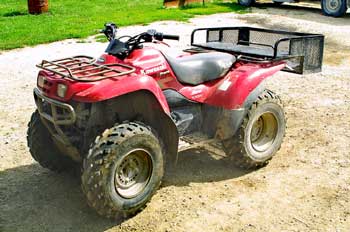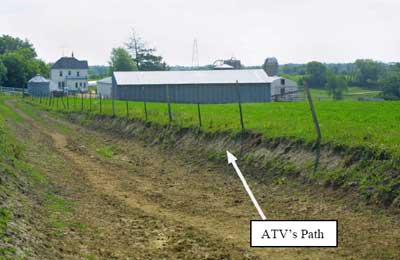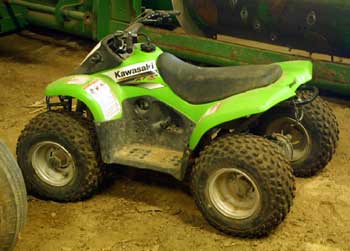Farm Boy Dies in ATV Rollover While Helping Father Chop Silage
Iowa Case Report: 04IA019
Report Date: July 22, 2005
Summary
During the summer of 2004, an eight-year-old farm boy was killed while helping his father and a neighbor chop hay for silage on their dairy farm. The father was driving a tractor pulling a silage chopper and silage wagon in the field. The boy was helping, driving to and from the field location on a 4-wheeled all-terrain vehicle (ATV) (Photo 1), and assisting in the hookup for each silage wagon. A neighbor was also helping by emptying the silage wagons into a blower which blew the silage into silage bags then transporting the empty wagon back to the field. The boy was driving the ATV back and forth on a dirt field drive, which was also used by dairy cows going to and from their pasture. After the last load of the evening, the boy was returning to the house on the ATV after 10 PM. He stopped on the side of the road and turned off the ATV’s lights. The neighbor drove by on his way home and noticed that the boy had stopped the ATV and was standing beside the road. After the boy got back onto the ATV, and before he turned on its lights, it appears he drove forward up a slight field embankment causing the ATV to roll over on its top and pinning him to the ground. When the father returned in his tractor later on the same road, he found the boy and the ATV upside-down with the handlebars on the boy’s chest. The boy was not breathing. The father immediately drove to the house to call for help then returned to his son.
 |
|
Photo 1 – Full-size ATV involved in this rollover.
|
Recommendations based on our investigation are as follows:
- Parents should be aware of laws concerning ATVs and follow recommendations for the appropriate size of machine for the age of the rider. Youth under the age of 16 should not operate full-sized ATVs.
- ATV operators should participate in a hands-on ATV safety training course.
Introduction
During the summer of 2004, an eight-year-old Iowa farm boy was killed while helping his father chop hay for silage. The Iowa FACE program was alerted to this incident by a newspaper article and immediately began an investigation, gathering information from the County Sheriff and the Medical Examiner. Contact was also made with the family, and a site visit was planned to view and photograph the ATV as well as the area where the ATV overturn occurred.
The farm was a dairy operation that milked 60 cows and had 280 acres (113 hectares) tillable in rotational cropping of corn, soybeans, and hay. The farmer also rented an additional 500-600 acres (200-240 hectares) and had several head of beef cattle. He had farmed and lived at this location with his family for the past 10 years. He normally worked alone but was occasionally aided by his wife and oldest son, who was eight years old at the time. On the day of this incident, the farmer was working with a neighbor chopping hay and being helped intermittently by his son.
This was a family farm: it did not have any type of safety program or written safety policies. Safety was considered to be a common-sense topic, discussed as needed for the job at hand. There were three ATVs on this farm. They were frequently used for farming chores and for recreation. Parental rules for riding these machines included riding only in low range, which limits the ATV’s top speed.
Investigation
The farmer and his neighbor had been cutting then chopping 90 acres (36 hectares) of hay and were working late into the evening to finish up the last load for the day. The farmer was driving the tractor pulling a silage chopper and silage wagon while his neighbor was helping transport and unload wagons into the blower for silage to be blown into the silage bag. The men were shuttling three silage wagons, and the farmer’s eight-year-old son was helping all day long by hooking up the silage wagons.
The silage chopper had a quick hitch with an automatic pin release, which meant the farmer could remotely unhook a filled silage wagon from the cab of his tractor. However, he still needed help to hookup to an empty wagon so his son would come out to the field to guide the tongue of the silage wagon into the automatic hitch at the back of the chopper. This procedure was performed about 50 times that day. The boy drove himself back and forth on the combination cattle lane and field road (Photo 2) using the 4-wheeled ATV as his transportation.
 |
|
Photo 2– View of the field drive and the approximate location of the rollover. The field is about three feet higher than the road.
|
The ATV was a 360 cc engine displacement, full-sized machine his father had purchased a few months earlier. The boy had ridden this machine up and down the dirt field drive many times that day, and had unrestricted access to the farm grounds on which to ride the ATV in the previous weeks and months. The boy was accustomed to driving this machine, and the father was confident of his son’s abilities.
There were two other ATVs on this farm at the time of the incident: a smaller machine with a 50 cc engine (Photo 3) and an older full-size model with slightly more power than the 360 cc model. Parental safety rules for riding the new ATV were few, but the machine was always to be kept in low range which would limit its top speed.
 |
|
Photo 3– Much smaller ATV used by younger boys on this farm.
|
The men were working late into the evening and were finishing the last load in the field. After the boy hooked up the last wagon, he drove the ATV one final time down the field lane toward home. This lane was rough and had a few stones in the path as well as some large ruts from recent rains. The lane was lower than the field, about four feet (1.2m), leaving a sharp embankment at the edge of the field (Photo 2). When the neighbor was heading home, he noticed the ATV stopped at the side of this road, its lights off, and the boy standing by the edge of the road. The boy’s father drove the tractor and chopper toward home along the same route several minutes later. He discovered the ATV upside down at the edge of the road, with his son underneath, pinned to the ground by the handlebars of the machine. After removing the ATV, the father was aware the boy was not breathing. He then drove to his house to summon help.
The father remembers the ATV had the ignition turned on but the lights were turned off. From the ATV’s tracks and studying the terrain the next day, it was determined that the boy apparently started the ATV then, before turning on the lights, drove forward up the field embankment at an angle causing the ATV to overturn. The boy was not wearing a helmet at the time, but in this case it would not likely have protected him from the type of fatal injuries in this overturn. Tests later confirmed that the machine and its controls were all in normal operating condition.
Cause of Death
The cause of death was listed as “asphyxiation from compressive chest injury”.
Recommendations/Discussion
Recommendation #1: Parents should be aware of laws concerning ATVs and follow recommendations for the appropriate size of machine for the age of the rider. Youth under the age of 16 should not operate full-size ATVs.
Discussion: According to Iowa law, children 6-11 years old can only drive an ATV of 50 cc engine displacement or less, children 12-15 years old can drive an ATV of 80 cc or less, and youth must be 16 years old before legally driving a full-size ATV. Full-size ATVs have a range from 250 cc up to 750 cc and vary greatly in load capacity, wheelbase, and speed. These laws apply to the general public. They do not apply to ATVs in the agricultural use setting. Nonetheless, they are useful guidelines for parents in helping them determine what size of machine their children should ride.
The dry weight of the 360 cc ATV was about 600 lbs (275 kg). It had a high and low gear range as well as a gear for reverse. This was a full-size machine that the father had purchased for his own use around the farm. The older son was allowed to use this larger ATV. A younger brother, age 6, frequently drove the smaller 50 cc ATV and naturally assumed possession of it, which allowed the older boy to gladly lay claim to the larger ATV. Operation of full-sized ATVs should be reserved for a later time when youth are bigger, have faster reaction times, better judgment, and more experience.
On Iowa farms parents have full discretion to allow children to operate all types of equipment and machinery, including tractors, skid steers, trucks, and ATVs. It is not recommended that children operate machinery designed for adults, but on many family farms it is a common occurrence and viewed as a natural and important part of growing up on a farm. If the task is simple to accomplish, and there is no one else around to help, parents frequently rely on help from their children and sometimes make exceptions to safety rules or overestimating their child’s skills and abilities. Most children are very happy to help their parents on the farm. This may lead to very positive bonding, and be excellent training for their future. Regardless of these nurturing factors, many tasks are simply too dangerous for children and parents must exercise self-discipline in finding alternative methods to accomplish tasks safely.
In this case, the boy’s decision to not turn on the headlights may have been a critical factor in the overturn. A field embankment can be found many places, as can ditches and valleys. Parents should warn youngsters about these hazards if they are allowed use of ATVs. Even an adult rider could have easily been hurt in an overturn similar to this event. Six hundred pounds (275 kg) is enough to crush anyone if the full weight is transferred to the handlebars when the machine turns upside down.
Recommendation #2 ATV operators should participate in a hands-on ATV safety training course.
Discussion: Operators under 16-years-old may lack the judgment, physical size, and motor skills necessary to safely ride a large ATV, i.e., an ATV with engine displacement greater than 90 cc. Abrupt and variable changes in terrain and high speed operation can cause loss of control, and this risk increases when operation is at night. Participation in effective, hands-on learning can help instill safe operating practices, such as wearing a helmet and never carrying passengers, as well as establish realistic parameters in which youth can safely operate an ATV of the proper size for them.
The ATV industry has participated in the development of educational training materials, hands-on ATV rider safety courses, and the identification of instructors. A number of other groups and agencies also provide materials and sponsor training sessions. Local ATV dealers, the Cooperative Extension Service, and the ATV Safety Training Institute can provide additional information and the schedule for training sessions.
References
- APA. All-Terrain Vehicle Injury Prevention: Two-, Three-, and Four-Wheeled Unlicensed Motor Vehiclesexternal icon. Elk Grove Village, IL: American Academy of Pediatrics. Available at: http://pediatrics.aappublications.org/content/105/6/1352.full.pdf+html. Accessed 22 July 2005. (Link Updated 11/15/2011)
- ASI. ATV Rider Course. Irvine, CA: All-Terrain Vehicle Safety Instituteexternal icon. Available at: http://www.atvsafety.org/. Accessed 22 July 2005.
- CPSC. All-Terrain Vehicle Safetypdf iconexternal icon. Washington, CD: Consumer Product Safety Commission. Available at: http://www.cpsc.gov//PageFiles/112051/540.pdf. (Link updated 5/28/2013.)
- Levenson, M. January 2003. All-Terrain Vehicle 2001 Injury and Exposure Studiespdf iconexternal icon. Washington, DC: Consumer Product Safety Commission. Available at: http://www.cpsc.gov/pagefiles/102410/atvex2001.pdf. Accessed 22 July 2005. (Link updated 4/8/2013)
- NASD. ATV Safety Packetexternal icon. Atlanta, GA: Centers for Disease Control. National Agricultural Safety Database. Available at: http://www.nasdonline.org/document/993/d000976/atv-safety-packet.html. Accessed 22 July 2005. (Link updated 10/5/2009)
Iowa FACE Program
FACE is an occupational fatality investigation and surveillance program of the National Institute for Occupational Safety and Health (NIOSH). In the state of Iowa, The University of Iowa, in conjunction with the Iowa Department of Public Health carries out the FACE program. The NIOSH head office in Morgantown, West Virginia, carries out an intramural FACE program and funds state-based programs in Alaska, California, Iowa, Kentucky, Massachusetts, Michigan, Minnesota, Nebraska, New Jersey, New York, Oklahoma, Oregon, Washington, West Virginia, and Wisconsin.
The purpose of FACE is to identify all occupational fatalities in the participating states, conduct indepth investigations on specific types of fatalities, and make recommendations regarding prevention. NIOSH collects this information nationally and publishes reports and Alerts, which are disseminated widely to the involved industries. NIOSH FACE publications are available from the NIOSH Distribution Center (1-800-35NIOSH).
Iowa FACE publishes case reports, one page Warnings, and articles in trade journals. Most of this information is posted on our web site listed below. Copies of the reports and Warnings are available by contacting our offices in Iowa City, IA.
The Iowa FACE team consists of the following from the University of Iowa: Craig Zwerling, MD, PhD, MPH, Principal Investigator; John Lundell, MA, Coordinator; Murray Madsen, Trauma Investigator; Risto Rautiainen, PhD, Co-Investigator; and John Kraemer, PA, from the Office of The State Medical Examiner.
To contact Iowa State FACE program personnel regarding State-based FACE reports, please use information listed on the Contact Sheet on the NIOSH FACE web site Please contact In-house FACE program personnel regarding In-house FACE reports and to gain assistance when State-FACE program personnel cannot be reached.

